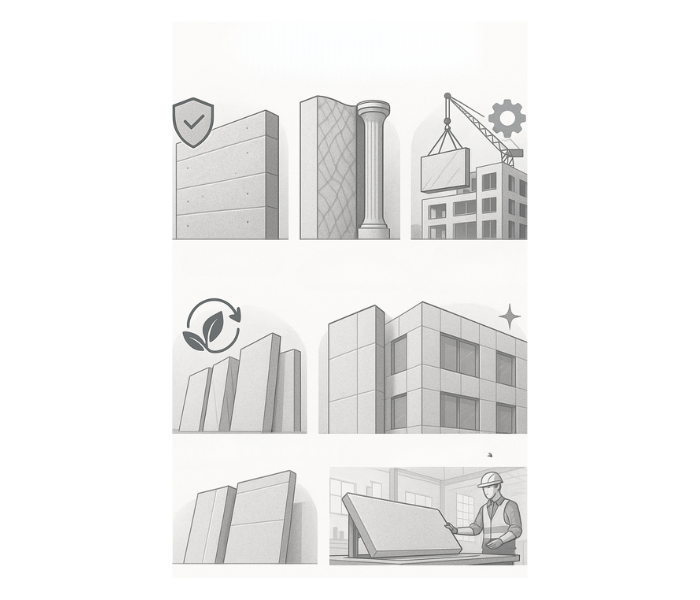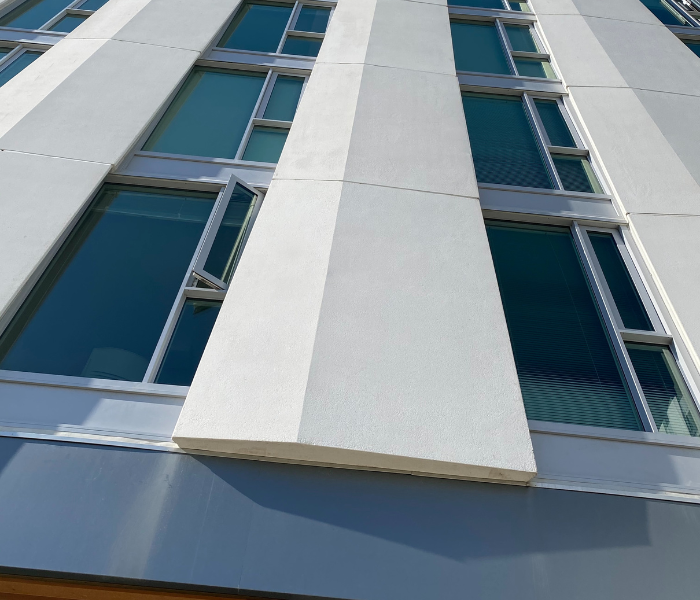Unlocking the Future of Design: The Benefits of Architectural Precast Concrete in Modern Construction
The Evolution of Precast Concrete in Construction
Architectural precast concrete has transformed the way we design and build structures, blending strength, precision, and artistic expression. From its early development to today’s advanced applications, this versatile material continues to shape modern architecture through innovation, sustainability, and design excellence.
The Evolution of Architectural Precast Concrete
The use of precast concrete in construction has a rich history that dates back to ancient times, but its modern application truly began in the early 20th century. Initially, precast concrete was used primarily for structural components such as beams and columns. However, as technology advanced, the versatility of this material became more apparent, leading to its adoption for a wide range of architectural elements. The evolution of precast concrete has been marked by continuous innovation, driven by the need for more efficient building methods and the desire for creative design solutions.
Innovation and Design in Modern Precast Applications
In the mid-20th century, the development of new manufacturing techniques and improved concrete mixes expanded the possibilities for precast concrete. Architects and engineers began to explore the potential of this material for creating complex shapes and intricate designs that were previously unattainable with traditional construction methods. This period saw the rise of iconic structures that showcased the aesthetic and functional benefits of precast concrete, setting the stage for its widespread use in contemporary architecture.
The Future of Precast Concrete in Architecture
Today, architectural precast concrete is a staple in modern construction, offering unparalleled advantages in terms of design flexibility, sustainability, and durability. The material’s evolution continues as advancements in technology and manufacturing processes open new avenues for its application. From urban skyscrapers to residential buildings, precast concrete has proven to be a vital component in the quest to build resilient, efficient, and visually stunning structures. As we delve deeper into the benefits of this innovative material, it becomes clear why precast concrete is poised to shape the future of design.
Key Benefits of Using Architectural Precast Concrete

Architectural precast concrete delivers both performance and beauty, making it one of the most versatile materials in modern construction. Its innovative production methods and adaptable design options provide architects and builders with creative freedom, faster installation, and long-lasting durability.
Efficiency and Quality Control
One of the most significant advantages is its ability to streamline the building process. Precast concrete components are manufactured off-site in controlled environments, ensuring consistent quality and reducing the likelihood of construction delays. This off-site production also allows for simultaneous on-site preparation, leading to faster project completion times.
Superior Aesthetic Versatility
Another key benefit of precast concrete is its superior aesthetic appeal. Unlike traditional concrete, which often requires extensive finishing work, precast concrete can be molded into a variety of shapes, textures, and finishes. This versatility allows architects to achieve unique and intricate designs that enhance the visual appeal of a building. Whether it’s creating smooth, polished surfaces or incorporating detailed patterns, precast concrete offers endless possibilities for creative expression.
Durability and Structural Strength
Durability and longevity are also standout features of architectural precast concrete. This material is highly resistant to weathering, corrosion, and other environmental factors that can compromise the integrity of a structure. As a result, buildings constructed with precast concrete require less maintenance and have a longer lifespan. Additionally, the inherent strength of precast concrete provides excellent structural support, making it suitable for a wide range of applications, from high-rise buildings to bridges.
Design Flexibility and Aesthetic Appeal
In an era where sustainability is a critical consideration in construction, architectural precast concrete stands out as an eco-friendly option. The production process for precast concrete is highly efficient, with minimal waste generated. Any excess material can be recycled and reused, reducing the environmental impact of construction projects. Additionally, the controlled manufacturing environment allows for the optimization of resource use, further minimizing waste and energy consumption.
The thermal mass properties of precast concrete contribute to its sustainability credentials. This material has the ability to absorb and retain heat, which helps regulate indoor temperatures and reduce the need for artificial heating and cooling. As a result, buildings constructed with precast concrete can achieve significant energy savings, contributing to lower greenhouse gas emissions and a smaller carbon footprint. This makes precast concrete an attractive option for projects aiming to achieve green building certifications such as LEED or BREEAM.
Moreover, the durability and longevity of precast concrete mean that buildings require less maintenance and have a longer lifespan. This reduces the need for frequent repairs and replacements, which in turn lowers the consumption of resources and the generation of waste. By choosing precast concrete, architects and builders can create structures that are not only aesthetically pleasing and functional but also environmentally responsible. This aligns with the growing emphasis on sustainability in the construction industry and supports the development of greener, more resilient communities.
Cost Efficiency and Time Savings
Architectural precast concrete streamlines both design and construction.
Manufactured off-site under controlled conditions, each component ensures precision, reduces waste, and minimizes costly on-site adjustments.
By producing elements simultaneously with site preparation, projects move faster—saving time and labor. The result: early completion, predictable budgets, and long-term savings through durability and low maintenance.
APS Precast delivers efficiency at every stage—from concept to installation—helping your project stay on schedule and within budget.
One of the most compelling advantages of architectural precast concrete is its cost efficiency. The off-site manufacturing process allows for the production of high-quality components in a controlled environment, reducing the likelihood of defects and the need for costly on-site corrections. This precision translates to lower labor costs and fewer delays during the construction phase, contributing to overall budget savings.
The time savings associated with precast concrete are equally significant. Because components are produced off-site, the on-site construction process can proceed concurrently with the manufacturing of precast elements. This parallel workflow reduces the overall project timeline, allowing buildings to be completed more quickly than with traditional construction methods. Faster project completion not only reduces labor costs but also allows for earlier occupancy, which can be a critical factor in commercial developments.
Additionally, the durability and low maintenance requirements of precast concrete contribute to long-term cost savings. Buildings constructed with precast concrete are less susceptible to damage from environmental factors, reducing the need for repairs and maintenance over time. This longevity ensures that the initial investment in precast concrete provides lasting value, making it a cost-effective choice for a wide range of construction projects.
Structural Integrity and Durability

Architectural precast concrete is renowned for its structural integrity and durability, making it an ideal choice for buildings that need to withstand harsh conditions and heavy use. The material’s inherent strength allows it to support substantial loads, making it suitable for a variety of structural applications, from foundation elements to load-bearing walls and beams. This strength is further enhanced by the controlled manufacturing process, which ensures consistent quality and performance.
The durability of precast concrete extends to its resistance to environmental factors. Unlike traditional concrete, which can be susceptible to weathering and corrosion, precast concrete is highly resistant to moisture, chemicals, and temperature fluctuations. This makes it an excellent choice for buildings in challenging environments, such as coastal areas or regions with extreme weather conditions. The material’s resilience ensures that structures remain safe and functional over their lifespan, reducing the need for costly repairs and replacements.
In addition to its physical properties, precast concrete offers excellent fire resistance. The material’s non-combustible nature and ability to withstand high temperatures make it an ideal choice for buildings that require stringent fire safety standards. This fire resistance, combined with its structural strength and durability, makes precast concrete a reliable and secure option for a wide range of construction projects, from residential buildings to large-scale commercial developments.
Future Trends in Precast Concrete Technology
As the construction industry continues to evolve, so too does the technology and innovation behind architectural precast concrete. One emerging trend is the integration of digital design and manufacturing techniques, such as Building Information Modeling (BIM) and 3D printing. These technologies allow for greater precision and efficiency in the production of precast concrete components, enabling architects to create more complex and customized designs. The use of digital tools also facilitates better collaboration between designers, engineers, and manufacturers, leading to more streamlined and successful projects.
Another exciting development is the incorporation of advanced materials and additives into precast concrete mixes. Researchers are exploring the use of nanomaterials, such as graphene and carbon nanotubes, to enhance the strength, durability, and sustainability of precast concrete. These innovations have the potential to significantly improve the performance of the material, making it even more suitable for a wide range of applications. Additionally, the use of recycled and eco-friendly materials in precast concrete production is gaining traction, supporting the industry’s shift towards more sustainable practices.
The future of precast concrete technology also includes the development of smart and adaptive building systems. By integrating sensors and other smart technologies into precast concrete elements, it is possible to create buildings that can monitor and respond to environmental conditions in real-time. This can lead to improved energy efficiency, enhanced occupant comfort, and greater overall building performance. As these innovations continue to advance, the potential of architectural precast concrete to shape the future of construction becomes even more apparent.
Conclusion: Embracing Precast Concrete for Modern Architecture
Architectural precast concrete is undoubtedly a transformative material that offers numerous benefits for modern construction. Its design flexibility, aesthetic appeal, and structural integrity make it an ideal choice for a wide range of projects, from iconic landmarks to innovative residential developments. The material’s sustainability credentials and cost efficiency further underscore its value in an industry that is increasingly focused on creating resilient, eco-friendly buildings.
As we have explored, the evolution of precast concrete technology continues to unlock new possibilities for architects and builders. The integration of digital design tools, advanced materials, and smart building systems promises to enhance the performance and versatility of precast concrete even further. By embracing these innovations, the construction industry can continue to push the boundaries of what is possible, creating structures that are not only functional and durable but also visually stunning and environmentally responsible.
In conclusion, architectural precast concrete represents the future of design in modern construction. Its multifaceted benefits make it a powerful tool for addressing the challenges and opportunities of contemporary architecture. Whether you are an industry professional or a curious enthusiast, the potential of this remarkable material to shape the built environment is clear. As we look to the future, it is evident that precast concrete will play a pivotal role in redefining the possibilities of design and construction.
